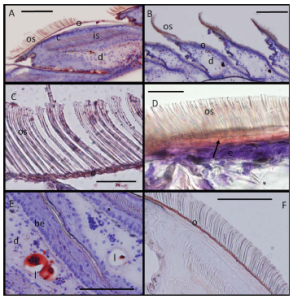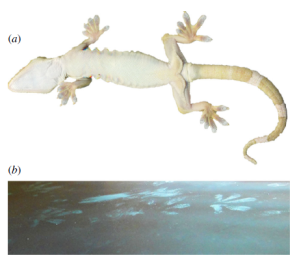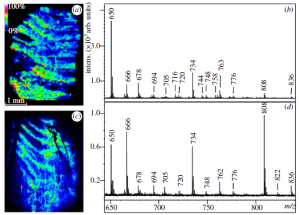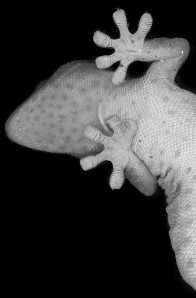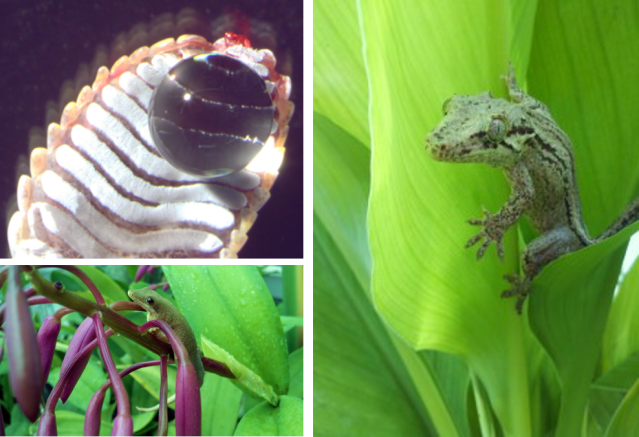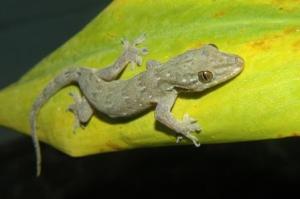Environmental Effects
In 2007 I started collaborating with Ali Dhinojwala in Polymer Science. His lab had already begun seeking a way to create synthetic mimics of gecko toepads…Gecko Tape. Our first experiment focused on testing the effects of temperature on adhesion in geckos, which we expected to be minimal. Our study, published in PlosOne revealed some unexpected effects of temperature as it interacted with relative humidity on the ability of geckos to stick to glass. It was our expectation that our study would help resolve some conflicting previous results of other labs. However, our main finding, that humidity has strong effects on gecko adhesion, more so at low temperatures than high, actually led to important questions about the materials (and properties) from which gecko setae are made (beta keratin). This has been a major focus of one of my graduate students (Alyssa Stark) co-advised by Ali Dhinojwala, and in collaboration with several graduate students in his lab. Alyssa is now a postdoc in the lab of Steve Yanoviak.
Materials
Work in this area has gone in two directions. The first is classical histology driven by a collaboration with Ali Dhinojwala, Deepak Edward and Lorenzo Alibardi. A study we published in The Journal of Morphology showed that the setae of some geckos and anoles appear to be covered with or contain lipids. That is, at a microscopic scale, sections reveal that it may not just be proteins that are at the contact interface between the spatula of the setae and the substrate. This finding surprised us, and we thought it quite significant considering that most of the models of how geckos stick are based on the assumption that it is the proteins of the skin (beta keratin) that make contact with the surface when geckos stick.
Our finding of the lipids led to the second direction of research which involved an different set of techniques investigating material aspects of the setae at the much smaller length scale of nanometers. In order to determine what molecules are actually present at the contact interface, a sophisticated imaging technique perfected in Ali Dhinojwala’s lab (sum frequency generation spectroscopy; SFG), and a type of chemical analysis called NALDI (a technique and instrumentation perfected in the lab of Chrys Wesdemiotis) were use. Our graduate students, subsequent to the discovery of lipids on the setae, noticed during experiments that geckos appeared to leave faint footprints behind when they walked on glass. Analysis of the setae contact interface and footprints with the techniques above revealed more two more surprising results, published in Interface. First, when setae come into contact with glass, lipids appear to be the material that ‘connects’ the glass with the skin. Second, when the setae are in contact with the glass, there is no evidence that water is present in that interface. Both of these findings suggest we need to rethink models of gecko adhesion, especially in the context of how environmental parameters like humidity or temperature might affect “stickiness.”
Materials papers 2012-2014
In June we published a paper on self-cleaning in geckos that resulted from collaborating with Zhenhai Xia and Shihao Hu, a professor and PhD student, respectively, in Mechanical Engineering at UA. Zhenhai is now at The University of North Texas, and Shihao is a postdoc at Case Western Reserve University. One of my masters students, Stephanie Lopez, had completed a difficult experiment to examine self-cleaning in geckos at the whole animal scale, a study which showed that rates of self-cleaning could be twice as high as reported from studies that looked at rates of cleaning at the scale of individual setae. Hu and Xia derived a model based on a very novel mechanism and verified that their model made predictions consistent with our empirical results. You can read the abstract of the paper published in Royal Society Interface…email me if you would like a pdf.
Photos (above) taken by Alyssa Stark, show studies she conceived, designed and directed producing some of the first data quantifying the effect of surface water on the ability of geckos to stick to glass and other materials. Contact Alyssa or me if you would like a pdf. More papers on this topic are listed below. Let me know if you would like a pdf.
- Stark, A.Y., Wucinich, N.A., Paoloni, E.L., Niewiarowski, P.H. & Dhinojwala, A. In press. Self-drying: A gecko’s innate ability to remove water from wet toe pads. PLoS ONE. Link
- Stark, A.Y., McClung, B., Niewiarowski, P.H. & Dhinojwala, A. 2014. Reduction of Water Surface Tension Significantly Impacts Gecko Adhesion Underwater. Integrative and Comparative Biology. Published early online (doi:10.1093/icb/icu066). Link
- Stark, A.Y., Badge, I., Wucinich, N.A., Sullivan, T.W., Niewiarowski, P.H. & Dhinojwala, A. 2013. Surface Wettability Plays a Significant Role in Gecko Adhesion Underwater. Proceedings of the National Academy of Sciences USA. 110(16):6340-6345. Link
- Hsu, P.Y., Ge, L., Li, X., Stark, A.Y., Wesdemiotis, C., Niewiarowski, P.H. & Dhinojwala, A. 2011. Direct evidence of phospholipids in gecko footprints and spatula-substrate contact interface detected using surface-sensitive spectroscopy. Journal of the Royal Society Interface. 9(69):657-664. Link
Behavior/Physiology
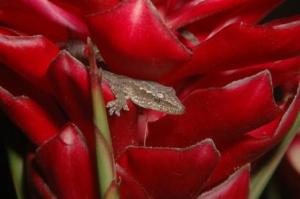 We have several ongoing projects, one just published in Journal of Herpetology compares locomotor performance and adhesion between invasive house geckos and resident mournful geckos in Moorea, French Polynesia. take a look at the abstract and drop me an email if you want a PDF.
We have several ongoing projects, one just published in Journal of Herpetology compares locomotor performance and adhesion between invasive house geckos and resident mournful geckos in Moorea, French Polynesia. take a look at the abstract and drop me an email if you want a PDF.
A second project was the work of one of my masters students (graduated May 2012), Eddie Ramirez, focusing on variation in digital hyperextension and its consequences for locomotor performance across different substrate types. Eddie is preparing the final 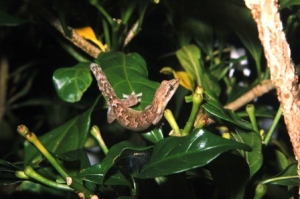 manuscript for submission.
manuscript for submission.

